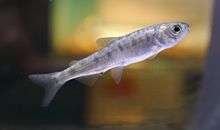Oncorhynchus kawamurae
| Oncorhynchus kawamurae | |
|---|---|
 | |
| A juvenile kunimasu at the Fuji Yusui no Sato Aquarium | |
| Scientific classification | |
| Kingdom: | Animalia |
| Phylum: | Chordata |
| Class: | Actinopterygii |
| Order: | Salmoniformes |
| Family: | Salmonidae |
| Genus: | Oncorhynchus |
| Species: | O. kawamurae |
| Binomial name | |
| Oncorhynchus kawamurae D. S. Jordan & E. A. McGregor, 1925 | |
Oncorhynchus kawamurae, the black kokanee, or kunimasu (国鱒 or クニマス) in Japanese,[1] is a Japanese species of salmon which was thought to had gone extinct in 1940, but was discovered to still have a living population in 2010.[1]
Oncorhynchus kawamurae is related to the sockeye salmon, Oncorhynchus nerka, and has been earlier treated as its subspecies O. nerka kawamurae. The fish was thought to have gone extinct in 1940 when a hydroelectric project made Lake Tazawa, its native lake, more acidic. Prior to that, 100,000 eggs were transferred to Lake Saiko, which is located about 310 miles (500 kilometres) south of Lake Tazawa, but this attempt to save the fish was thought to have been unsuccessful. However, in 2010, a team of researchers including a celebrity biologist, 'Sakana-kun', discovered living members of the species in Saiko Lake.[1]
The fish is dark olive with black spots on its back, and grows to approximately one foot (30 centimetres) in length.[2]
References
- ´Froese, Rainer and Pauly, Daniel, eds. (2012). "Oncorhynchus kawamurae" in FishBase. April 2012 version.
- 1 2 3 Ryall, Julian (4 February 2011). ""Extinct" Salmon Discovered in Japanese Lake". National Geographic.
- ↑ Associated Press (15 December 2010). "Japanese salmon species thought extinct found". NBC.